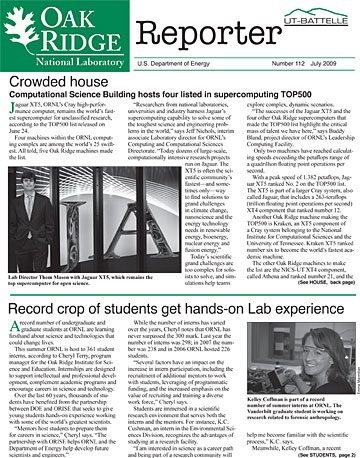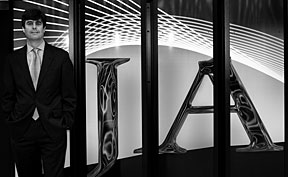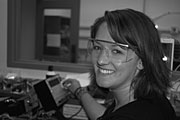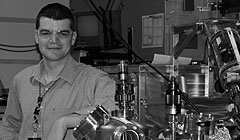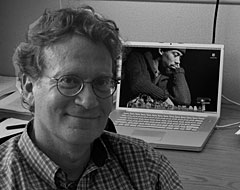 |
Number 112, July 2009 |
 Crowded house
Crowded house
Computational Science Building hosts four listed in supercomputing TOP500
|
|
Lab Director Thom Mason with Jaguar XT5, which remains the top supercomputer for open science. |
Jaguar XT5, ORNL’s Cray high-performance computer, remains the world’s fastest supercomputer for unclassified research, according to the TOP500 list released on
June 24.
Four machines within the ORNL computing complex are among the world’s 25 swiftest. All told, five Oak Ridge machines made the list.
“Researchers from national laboratories, universities and industry harness Jaguar’s supercomputing capability to solve some of the toughest science and engineering problems in the world,” says Jeff Nichols, interim associate Laboratory director for ORNL’s Computing and Computational Sciences Directorate. “Today dozens of large-scale, computationally intensive research projects run on Jaguar. The XT5 is often the scientific community’s fastest—and sometimes only—way to find solutions to grand challenges in climate change, nanoscience and the energy technology needs in renewable energy, bioenergy, nuclear energy and fusion energy.”
Today’s scientific grand challenges are too complex for soloists to solve, and simulations help teams explore complex, dynamic scenarios.
“The successes of the Jaguar XT5 and the four other Oak Ridge supercomputers that made the TOP500 list highlight the critical mass of talent we have here,” says Buddy Bland, project director of ORNL’s Leadership Computing Facility.
Only two machines have reached calculating speeds exceeding the petaflops range of a quadrillion floating point operations per second.
With a peak speed of 1.382 petaflops, Jaguar XT5 ranked No. 2 on the TOP500 list. The XT5 is part of a larger Cray system, also called Jaguar, that includes a 263-teraflops (trillion floating point operations per second) XT4 component that ranked number 12.
Another Oak Ridge machine making the TOP500 is Kraken, an XT5 component of a Cray system belonging to the National Institute for Computational Sciences and the University of Tennessee. Kraken XT5 ranked number six to become the world’s fastest academic machine.
The other Oak Ridge machines to make the list are the NICS-UT XT4 component, called Athena and ranked number 21, and the NCCS’s Eugene, an IBM Blue Gene/P system that ranked number 247.
In 2008 Jaguar was a 263-teraflops Cray XT4. It was upgraded with the addition of a 1.4 petaflops Cray XT5 component in the fall. An InfiniBand network connects Jaguar’s components for faster data production. With approximately 182,000 AMD Opteron processing cores, the combined system can calculate at a peak rate of 1.64 petaflops. If each person on earth could perform one mathematical calculation per second, it would take more than 650 years of nonstop work to accomplish what Jaguar XT4/XT5 can in a day.
“The Jaguar system helps the scientific community gain insight into topics critical to DOE and the nation, such as mitigating and adapting to climate change, making efficient photovoltaic materials, producing next-generation biofuels, and controlling plasma in a fusion reactor,” says NCCS Director Jim Hack.
Such simulations have run hundreds of millions of processor hours on the Jaguar system.—Dawn Levy ![]()
 Record crop of students get hands-on Lab experience
Record crop of students get hands-on Lab experience
|
Kelley Coffman is part of a record number of summer interns at ORNL. The Vanderbilt graduate student is working on research related to forensic anthropology. |
A record number of undergraduate and
graduate students at ORNL are learning firsthand about science and technologies that could change lives.
This summer ORNL is host to 361 student interns, according to Cheryl Terry, program manager for the Oak Ridge Institute for Science and Education. Internships are designed to support intellectual and professional development, complement academic programs and encourage careers in science and technology.
Over the last 60 years, thousands of students have benefited from the partnership between DOE and ORISE that seeks to give young students hands-on experience working with some of the world’s greatest scientists.
“Mentors host students to prepare them for careers in science,” Çheryl says. “The partnership with ORISE helps ORNL and the Department of Energy help develop future scientists and engineers.”
While the number of interns has varied over the years, Cheryl notes that ORNL has never surpassed the 300 mark. Last year the number of interns was 298; in 2007 the number was 238 and in 2006 ORNL hosted 226 students.
“Several factors have an impact on the increase in intern participation, including the recruitment of additional mentors to work with students, leveraging of programmatic funding, and the increased emphasis on the value of recruiting and training a diverse work force,” Cheryl says.
Students are immersed in a scientific research environment that serves both the interns and the mentors. For instance, K.C. Cushman, an intern in the Environmental Sciences Division, recognizes the advantages of studying at a research facility.
“I am interested in science as a career path and being part of a research community will help me become familiar with the scientific process,” K.C. says.
Meanwhile, Kelley Coffman, a recent graduate of Vanderbilt University, will be assisting Arpad Vass with research in the area of forensic anthropology. Arpad is developing a device that detects chemicals from the bones of decomposing bodies. Kelly, who will learn how to use this device and record data from its findings, is looking forward to pursuing the rare opportunities that ORNL has to offer.
“I think my experience will be enjoyable because I am being exposed to things that I would normally not have access to, such as the body farm,” Kelly says. “Ultimately, my academic research goal is to write a paper that will be published in a peer-reviewed journal.”
The “body farm,” formally known at the University of Tennessee as the Anthropological Research Facility, enables students and researchers to study decomposing bodies in varied settings and scenarios. Information gained from the facility helps law enforcement agencies and forensics experts across the nation.
Although an emphasis remains on designing and completing an individual research project, interns have opportunities to participate in weekly scientific seminars, brown bag sessions, a poster session and a graduate fair.
Students expect to face challenges as the summer progresses: Construction in ORNL’s main campus of the $95 million Chemical and Materials Science facility forced the closing of a parking lot, making even the daily task of finding a parking space difficult. The record number of interns has made office space a premium, and seats in the cafeteria during lunchtime can be scarce—Emma Macmillan ![]()
Emma Macmillan is a summer intern from the University of Tennessee’s science writing program, working in the Communications and External Relations office.
 Martin Keller to lead BESD
Martin Keller to lead BESD
|
Keller |
Martin Keller has been named to lead the
Biological and Environmental Sciences Directorate, effective July 1.
As associate Laboratory director, Martin will integrate the directorate’s biological capabilities with high-performance computing, nanotechnology and catalysis with a thrust toward integrating ecological and molecular environmental research in climate and carbon modeling.
He came to ORNL from the Diversa Corporation in San Diego, Calif., where he directed new technology development and high throughput screening. At ORNL, he has served as director of BESD’s Biosciences Division and as director of the BioEnergy Science Center.
ORNL Director Thom Mason says Martin has been instrumental in one of the DOE’s most visible and progressing programs.
“I am excited by Martin’s vision for integrating our growing biological capabilities with high-performance computing, nanotechnology and catalysis. In the years ahead we will have a unique chance to integrate ecological and molecular environmental research with our strengths in climate and carbon modeling,” Thom says.
A native of Germany, Martin earned his doctorate in microbiology at the University of Regensburg, Germany.
He succeeds Gary Jacobs, who served as the BESD interim director over the past nine months.
Martin, his wife, Sibylle, and their three children live on a farm in Knoxville, where they raise alpacas. Their extended family includes dogs, cats, horses and chickens.—Joanna Finney ![]()
 Governor’s Chair Liu to study grid
Governor’s Chair Liu to study grid
|
Liu |
Power-grid technologies expert Yilu Liu is the fourth member of the University of Tennessee-ORNL Governor’s Chair.
Liu comes to ORNL from Virginia Tech, where she directed the Center for Power Engineering. She will hold appointments in ORNL’s Energy & Transportation Science Division and UT’s department of electrical engineering and computer science.
The Governor’s Chair program attracts accomplished researchers around the world in an effort to boost joint research. The partnership leads in fields of biological science, computational science, advanced materials and neutron science. ORNL’s Electric Grid Research and Development Program conducts about $20 million in research each year.
While developing ways to monitor and understand the flow of energy through the nation’s power grid on a large scale, Liu will research ways to develop the “smart grid,” a term describing the next generation of electric transmission technology that will move energy more efficiently and effectively.
“A smarter, more efficient power grid is vital to the nation’s energy plan and a key part of ORNL’s research portfolio,” says ORNL Director Thom Mason. “Dr. Liu’s work will greatly strengthen our scientific efforts to address this energy challenge.”
Jeremy Smith of the Biosciences Division and Center for Molecular Biophysics, Alexei Sokolov of the Chemical Sciences Division and Howard Hall of the Global Nuclear Security Division are ORNL’s other Governor’s Chair researchers. ![]()
 ORNL top HBCU supporter
ORNL top HBCU supporter
The nation’s engineering deans at Historically Black Colleges and Universities have named ORNL a “2009 Top Supporter of HBCUs and Minority Serving Institutions.”
The award was presented to corporations and government agencies during ceremonies at the HBCU Response and Professional Connections Conference on May 29, at Howard University, in Washington, D.C.
The survey of deans is conducted by U.S. Black Engineer and Information Technology magazine. Participants in the survey included deans of the ABET-accredited engineering programs at HBCUs across the country.
The deans considered factors such as infrastructure upgrade and modernization, research collaboration, faculty development and the hiring of new graduates.
ORNL was also a top supporter in 2007. ![]()
 |
 Five years ago, the president
Five years ago, the president
Five years ago this month, ORNL experienced its most recent presidential visit. President George W. Bush arrived at ORNL on a trip billed as a tour of antiterror programs, an example of which was a cache of equipment from Libya’s abandoned nuclear effort.
Bush’s July 12, 2004, talk in Wigner Auditorium focused on national security.
“The global threat of terrorism requires a global response. To be effective, that global response requires leadership—and America will lead,” said the president.
The run-up to the visit, which was confirmed the week before, was a frenzied affair as Lab and DOE officials worked with the Bush advance team to provide for the president’s safety as well as host an international troupe of attending media. The visit came as the ‘04 presidential race was gathering momentum.
|
Gregory Knox got a photo-op with the president on July 12, 2004. |
Seating for Bush’s talk in Wigner Auditorium was scarce and mostly reserved for officials and visiting dignitaries. However, Lab staff members got a better opportunity to meet the president when his departing motorcade stopped on its way out of the 4500 canyon, and Bush emerged to mingle with the people lining the pathway.
Gregory Knox, then an intern in Facilities & Operations, got himself photographed with his arm around an apparently amused commander-in-chief. It was a rare, spontaneous moment in the eight-year Bush Administration. Where else but at ORNL?
 Weinberg Fellow program begins
Weinberg Fellow program begins
Alvin Weinberg was a tireless advocate of the genius of Eugene Wigner. Now Weinberg, who died in 2006, has an ORNL fellowship in his name, just as his mentor, Wigner, does.
Four early-career researchers have received the first Alvin M. Weinberg Fellowship appointments at ORNL.
The fellowship is awarded to leading young scientists and engineers in physical and biological sciences and engineering with interests in energy and energy-related science and technology challenges. The appointments run up to two years with a possible renewal for a third.
Jeff Bielicki, Brian Egle, Chad Parish, and Wyatt Tenhaeff begin what is projected to be a succession of Weinberg fellows at the Laboratory.
“These Weinberg fellows will work at the frontiers of fundamental science and engineering with the potential to transform critical energy technologies,” says Lab Director Thom Mason.
Weinberg, who directed ORNL for nearly two decades, was renowned as a nuclear pioneer and science administrator. He is credited with coining the term, “Big Science.”
The Wigner fellowships have attracted top talent to ORNL since 1975. About two-thirds of the fellows stay on to build distinguished careers as ORNL researchers. Now the Lab has the Weinberg fellowship to help attract top talent to the Lab.
Reported by Bill Cabage and Joanna Finney |
|
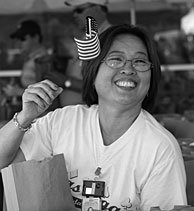 |
| Club ORNL’s car and motorcycle show on June 11 drew a crowd to the quad. A Ferrari (above) drew its own crowd. Hoa Burlingame (right), who was born in Vietnam, was one of many celebrants at the Multicultural Friendship Club’s LibertyFest on June 25. | |
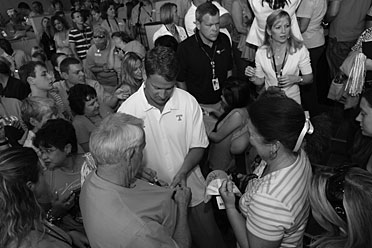 |
|
| University of Tennessee football coach Lane Kiffin visited ORNL with several of his coaching staff on June 23 to kick off this year’s United Way campaign. The coach autographed a number of items, including t-shirts. It’s Kiffin’s first year as the Vols’ coach; ORNL is coming off its first million-dollar campaign. | |
 First steps
First steps
Wigner Fellow Maksymovych sets out to prove what is possible
|
Petro Maksymovych has compiled an impressive record since coming to ORNL as a Wigner Fellow. |
Leaving his Ukraine roots and destined for
the United States to pursue a scientific career, Petro Maksymovych was unaware of the abundance of possibilities he would encounter.
He earned a B.S. in chemistry from the Kiev Tara Shevchenko University in Ukraine and graduated from the University of Pittsburgh with a doctorate in physical chemistry. His work as a graduate student on single-molecule chemistry and physics on metal surfaces was recognized with the Morton M. Traum Award from the American Vacuum Society in 2006 and the Wayne B. Nottingham Prize from the Physical Electronic Conference in 2007.
Petro first arrived at the ORNL in 2007 as a Eugene P. Wigner Fellow. the two-year postdoctoral fellowship is named after Nobel laureate and first ORNL scientific director Eugene Wigner. He was 26. He is currently working under the supervision of John Wendelken, with his team-members Art Baddorf, Stephen Jesse and Sergei Kalinin at the Center for Nanophase Materials Sciences.
Petro’s research focuses on the fundamental nanoscale phenomena in ultrathin ferroelectric and multiferroic oxide films and the advanced scanning probe microscopy for imaging of dynamic functionality of nanoscale materials. In their latest study, Petro and colleagues have revealed the long-pursuit polarization-dependent electron transport through ferroelectric perovskite oxides, which presents “enticing possibilities for low-dimensional ferroelectric applications, as well as the fundamentally new electron transport properties of these materials,” he says.
“One of the things I wanted was to do something completely different than what I did as a graduate student,” says Petro. “I first considered ferroelectrics when writing a research proposal as part of the graduation requirement. During my job search I came across Art and Sergei and ultimately ended up working in a great team!”
In his research he hopes to inspire the search for the possibilities that intrinsic phase transitions of nanoscale materials offer for energy and electronically relevant applications.
“Our job as scientists is to prove the very first step,” says Petro. “To show that it is possible, not to exemplify necessarily the actions of the possibilities.”
Petro still finds time to dabble in activities outside of work, such as playing with the latest computer technology by plucking parts into his PC and “modding” the operating system. At home, although he doesn’t have a furry friend because the departure of his last one was “too tragic,” he enjoys good company, spending time with his wife, going hiking, attending underground musical theaters and learning how to play guitar, “a major affection,” says Petro.
Since arriving at ORNL, Petro has already authored or co-authored a number of papers in major peer-reviewed journals. Yet with all his success, Petro has a humble presence.
“Try to participate in student competitions at the end of your degree training; it’s not about fame and glory; that’s nonsense”, says Petro. “It’s about tossing your elbows with your peers and getting real exposure for your work, which is important because it also gives you a sense of perspective.” —Joanna Finney ![]()
Joanna Finney is a summer intern from the University of Tennessee’s science writing program. She is working in the Communications and External Relations office.
 Metrology Lab now NIST-accredited in laser calibration
Metrology Lab now NIST-accredited in laser calibration
Following a thorough analysis, the National Institute of Standards & Technology has accredited ORNL’s Metrology Laboratory for laser frequency and wavelength calibrations.
Now, for the first time, ORNL researchers and machinists have access to technology to improve their dimensional measurements that would formerly have been available only at NIST.
“We did such a good job writing the data that NIST didn’t have to come to ORNL to issue us an accreditation,” says Bill Wright of the Quality Systems and Services Division.
“Take two laser beams, or other coherent light sources, intersect them, and a series of light and dark bands form. The distance formed at the intersection is fringe space. This space is how very small spaces, micrometers, are measured,” says metrology program manager Mike Duncan.
Laser interferometry is involved in making precise dimensional measurements in the fabrication of virtually every machined part made. It is also used in the measurement of the velocity of items without requiring that anything actually touch the item, such as paper going through a paper mill or air going through a wind tunnel.
Laser interferometry can determine the accuracy of machines and also tell users how to compensate. |
As a means of compensating for wear or inaccuracies in machine tools, laser interferometry can be used to determine the accuracy of machines and also tell users how to compensate for inaccuracies in those machines.
One of the major contributors to the accuracy of these laser interferometer measurements is the frequency (or wavelength) of the laser light itself. An accurate determination of the frequency of a laser used in an interferometer results in a more accurate dimensional measurement using the interferometer.
“We’ve gone from no capability whatsoever to calibrate a laser interferometer to being able to calibrate at NIST level—.09 parts per billion. Lasers operate at parts per million,” says metrology standards and operations manager Greg Strickland.
Laser frequency measurement is so sensitive that almost imperceptible environmental blips, such as footsteps or even body heat, can affect the accuracy. But the measurements themselves are infinitesimally precise.
NIST has encouraged ORNL’s growing capability in laser frequency measurement calibration and other measurement disciplines as the Department of Commerce agency focuses more on research and development.
“We have a capability ready to go. Any lasers used for precision measurement should be calibrated,” Greg says.
Besides NIST, ORNL and the U.S. Air Force now have the only two accredited U.S. laboratories for laser frequency calibration.—Joanna Finney ![]()
 Flow & eddy
Flow & eddy
Jaguar XT4 tracks pollutants in a global eddying ocean model
|
The least movement is of importance to all nature. The entire ocean is affected by a pebble,” said Blaise Pascal. Pascal, a mystic at heart, may have overstated the case. However, researchers today increasingly recognize the influence of the ocean on climate. They want to know how the ocean is coping with vast deposits of chemical pollutants, how it moves them about, stores them over long periods of time, and ultimately redistributes them at the surface with the air.
Using the Cray XT4 Jaguar at the Oak Ridge Leadership Computing Facility, they have built simulations to assess with greater precision the long-term relationship between this oceanic housekeeping and climate change.
Oceans play a critical role in the earth’s balance of heat, water and chemicals such as carbon dioxide (CO2) and chlorofluorocarbons (CFCs). After absorbing chemicals from the atmosphere at the surface, the ocean can store substances for hundreds to thousands of years, circulating them through 319 million cubic miles of water around the globe. Climate change can affect this process, called ventilation. But how much? And how fast?
Jaguar is one of the few computers with computing power for a 100-year simulation at very high resolution, carrying multiple tracers. |
Eddy pathways and the timescales on which they move are very difficult to measure, but can be inferred from observations of dissolved chemical compounds, or tracers. CFCs, which were introduced in the 1930s and are now being phased out, are a good tool for tracking the transport of chemicals through the global ocean.
Using the Cray XT4 Jaguar, Synte Peacock and Frank Bryan at the National Center for Atmospheric Research and Mathew Maltrud at Los Alamos National Laboratory have for the first time carried out a simulation that shows the pattern of eddys in the ocean over 100 years. The Global Eddying Ocean Model carried not only CFCs but also other tracers that yielded valuable information about the pathways and the timescales on which the chemicals were transported. The team has been able to reassess earlier estimates of CFC concentrations, which had linked changes in concentrations to climate change.
Researchers know at what temperature CFCs become soluble in water, and they know that, once in the water, CFCs don’t react with anything. By comparing a CFC concentration deep in the ocean to its surface value, scientists can estimate how long it has been since that water parcel was last at the surface.
But CFCs have only been in the atmosphere for decades, not millenia. To understand the ventilation process, researchers also need to know how the water was transported to the observed location. Here, ocean general circulation models provide insight into such transport.
Previous simulations used coarse grid spacing greater than 100 kilometers. Researchers needed a resolution of kilometers to tens of kilometers to resolve narrow currents and mesoscale eddies (circular loop-like features with a diameter of less than 200 kilometers).
Jaguar is one of the few computers with computing power for a 100-year simulation at very high resolution, carrying multiple tracers. To assess the accuracy of the model’s eddy strength, researchers compared simulated changes in sea-surface height with actual measurements from satellite altimeters and found unprecedented agreement. The NCAR/LANL model is one of the most realistic global eddying models ever run, Maltrud says.
Oceanographers use changes in concentrations of tracers (typically measured five to 10 years apart at the same location) to infer whether there are fundamental shifts in circulation pathways or timescales. Earlier studies had noted apparent changes in the CFC concentrations in the global ocean and had attributed these to changes driven by changing climate.
|
The Cray XT4 Jaguar. |
Peacock and her colleagues developed five simulations, each with a sample CFC distribution. They found only marginally significant changes in a number of places where earlier studies had taken measurements, and that most were attributable to “noise” (variations in heat and cold, salt and CFC concentrations in different parts of an eddy). These results, the first of their kind, are important both for comparing models with actual samplings and helping scientists interpret the observational record.
“This will help researchers better understand the role of the ocean in uptake and redistribution of gases such as anthropogenic (man-made) CO2), which will ultimately increase understanding of the role that oceanic activity plays in climate change,” Peacock says.—Agatha Bardoel
Agatha Bardoel writes for the Computing and Computational Sciences Directorate. ![]()
 Medical, lung screenings available to ORNL employees
Medical, lung screenings available to ORNL employees
Former ORNL and Y-12 workers have the opportunity to obtain an independent assessment of their health in relation to their work-place exposures by participating in a medical screening and research program called the Worker Health Protection Program (WHPP), offered by Queens College of the City of New York.
Though jointly run with the ATLC, the WHPP physical is available to both hourly and salaried former workers. To be eligible for the screening physical, applicants must be a former employee of a DOE contractor at ORNL or Y-12 for at least 30 days.
The medical evaluation, performed locally at clinics in Oak Ridge and Knoxville, includes a complete medical exam, a chest X-ray, hearing and breathing tests, and blood work including a beryllium blood test (BeLPT) that detects beryllium sensitivity. The doctors will look for certain work-related illnesses, such as asbestosis, hearing loss, silicosis, some cancers and chronic beryllium disease.
Queens College physicians will provide a letter detailing results and, if applicable, will recommend follow-up care for abnormalities. The doctors in this program are not employed by or affiliated with DOE or its contractors. Medical information remains confidential.
Low-dose CT scans available to current, former workers with lung cancer risk.
The WHPP medical screening program now includes lung cancer screening for current and former ORNL and Y-12 workers at elevated risk for lung cancer, including those with occupational exposures to lung carcinogens such as asbestos, uranium, plutonium and beryllium. Unlike the screening physical exam, the lung cancer screening program is available to both former and current hourly and salaried workers who meet the selection criteria.
The program utilizes low-dose, computerized axial tomography (CT) scanning, a relatively new technology that detects lung cancer more effectively than a chest X-ray and at an earlier stage, when the disease is more easily treatable. “Only 12 percent of lung cancers are now detected early, but with this new CT scan technique, we expect to be able to diagnose up to 60-80 percent of lung cancers at an early stage. By finding more cancers at an early stage, we hope to increase the number of people who survive lung cancer and extend the life of others”, says Dr. Steven Markowitz, director of the Queens College Center for the Biology of Natural Systems and the Worker Health Protection Program. The CT scanner is located adjacent to the ATLC union hall.
The program targets workers who are at elevated risk based on age, job title, first year of exposure to occupational toxins and years worked and/or smoking history. In addition, workers with evidence of asbestos-related disease on chest X-ray or at least one abnormal beryllium lymphocyte proliferation test (BeLPT) are eligible.
Screening is limited to 50 years of age or older (upper limit is 85 years old). The only exception to the age criteria is workers between the ages of 45 and 49 who have evidence of asbestos-related disease on chest X-ray or an abnormal BeLPT.
Former workers must first schedule a WHPP physical before Queens College can determine eligibility for the lung cancer screening program. To schedule an appointment for the physical, call the ATLC medical screening office, 865-483-8471 or 800-906-2019.
Current workers can call Queens College directly to determine if they are eligible for the low-dose CT scan: toll-free 1-866-228-7226. ORNL Management has agreed to provide up to 1.5 hours of paid time for eligible current workers to go to the mobile unit for the lung cancer screening. Speak to your supervisor for further details and approval. ![]()
 New Staff Members
New Staff Members
June 2009
David Craig Bader, Biological & Env. Sciences Dir.
Kayla Marshae Clark, Randal Dewayne Parks, Joseph Adam Carter, Jesse Alan Crabtree, Cory Jacob Hayes, Georgiella Claudean Thompson, Jerrell Benjamin Williams, Joshua Brent Moore, Bradley Aaron Bonifacius, Ryne Adam Fye, John Gordon Mee and Richard Dillon Willett, Campus Support & Instrumentation
Jason Robert Mclemore, Forrest Scott Roberts and Jessica Charlsene Baxter, Utilities
Clarice Evone Salone, Nonreactor Nuclear Facilities
Richard Michael Wallace, Measurement Science & Systems Engr
Gina Kristi Accawi, Energy & Transportation Science
Darlene Vanis Coffey Browning, Prime Contract Administration
Oscar Rafael Hernandez, Bobby Philip and Kyle Lee Spafford, Computer Science & Mathematics
Teresa Joan Mathews, Environmental Sciences
James Eugene Oran and Kendall Dwayne Summitt, Fabrication, Hoisting & Rigging
Wenduo Zhou, NScD Neutron Scattering Science
Robin Martin Floyd, Human Resources Dir.
David Jason Mandl, Legal Dir.
Kimberly Michelle Maples, Business Services Dir.
Adam M. Shephard, Global Nuclear Security Technology
Johnny Broyles and Christopher Lynn O’Malley, NScD Research Accelerator
Erik Michael Ferragut, Computational Sciences & Engineering (re-hire)
Jorge Alberto Suris, Measurement Science & Systems
 Club ORNL
Club ORNL
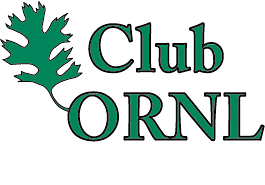 |
Get the details and latest news on Club ORNL online via the ORNL home page and on ORNL Today. Retirees, to gain access to the ORNL home page, first register in XCAMS by going to http://www.ornl.gov/adm/clubornl
_signup.shtml. After receiving your XCAMS account and Club ORNL membership, retirees can then go directly to https://www.ornl.gov/adm/clubornl. Ross Toedte, 574-1912, toedterj@ornl.gov, is the retiree point of contact.
 ORNL People
ORNL People
Fabio Casagrande, Spallation and Neutron Sciences Cryogenic System director, is this year’s winner of the Excellence in Cryogenic Operation and Support award from the Cryogenic Society of America. Fabio was nominated for his leadership toward improving availability of the SNS, completing the complex design modifications for operating the SNS and effectively supervising engineers and technicians.
Craig Blue, director of ORNL’s Energy Materials Program, has been elected a fellow of ASM International for his contributions to the field of materials science and engineering. Craig came to ORNL in 1995 and has been instrumental in the revitalization and evolution of the Materials Processing group.
Sharon Robinson, waste management systems and technology manager in the Nuclear Operations Directorate, has been elected fellow of the American Institute of Chemical Engineers, “for her distinctive professional accomplishments and contributions in chemical engineering.” Sharon will also receive from AIChE the Robert E. Wilson Award.
Hua-Tay Lin, leader of the Ceramic Science & Technology group in the Materials S&T Division, has been chosen to receive the Lee Hsun Lecture Award in recognition of his accomplishments in materials science and technology research. The award is presented by the Shenyang National Laboratory for Materials Science in China and the Institute of Metal Research, Chinese Academy of Sciences.
Tristam O. West has received the Environmental Sciences Division’s annual Stanley I. Auerbach Award. The award recognizes individuals for sustained, high-quality and creative scientific contributions to solving complex environmental problems. Winners of ESD’s annual Distinguished Achievement Awards in technical, administrative and operational support were Tammy Beaty, Roxanne Raschke, Jana Phillips and Nancy Engle.
ORNL Welding Services staff of the Fabrication Hoisting and Rigging Division recently earned certifications. Jeff Pryor was certified as Level III in Leak Testing by the American Society of Nondestructive Testing. Doug Kyle was certified by the state of Tennessee as a boiler inspector. ![]()
